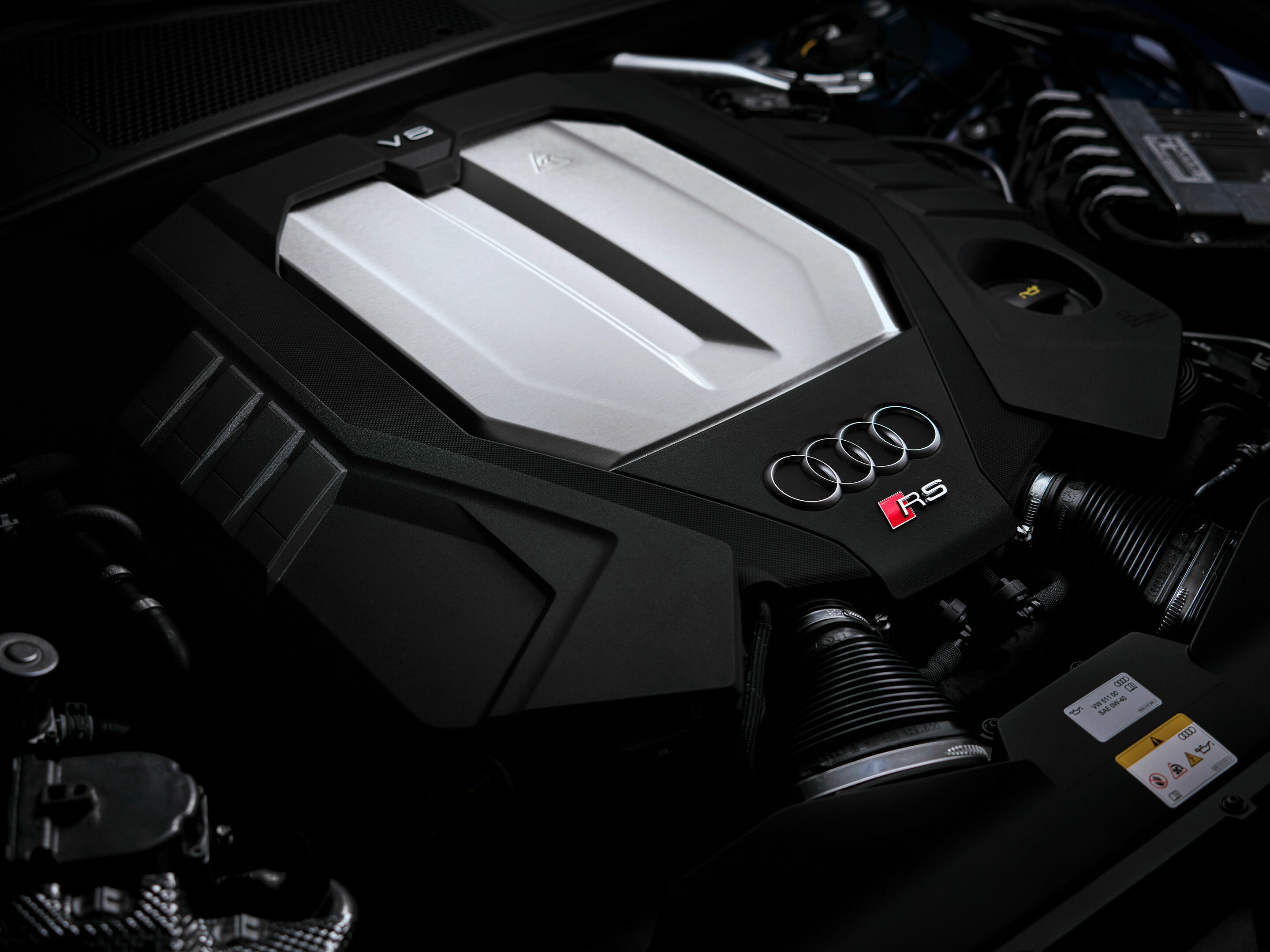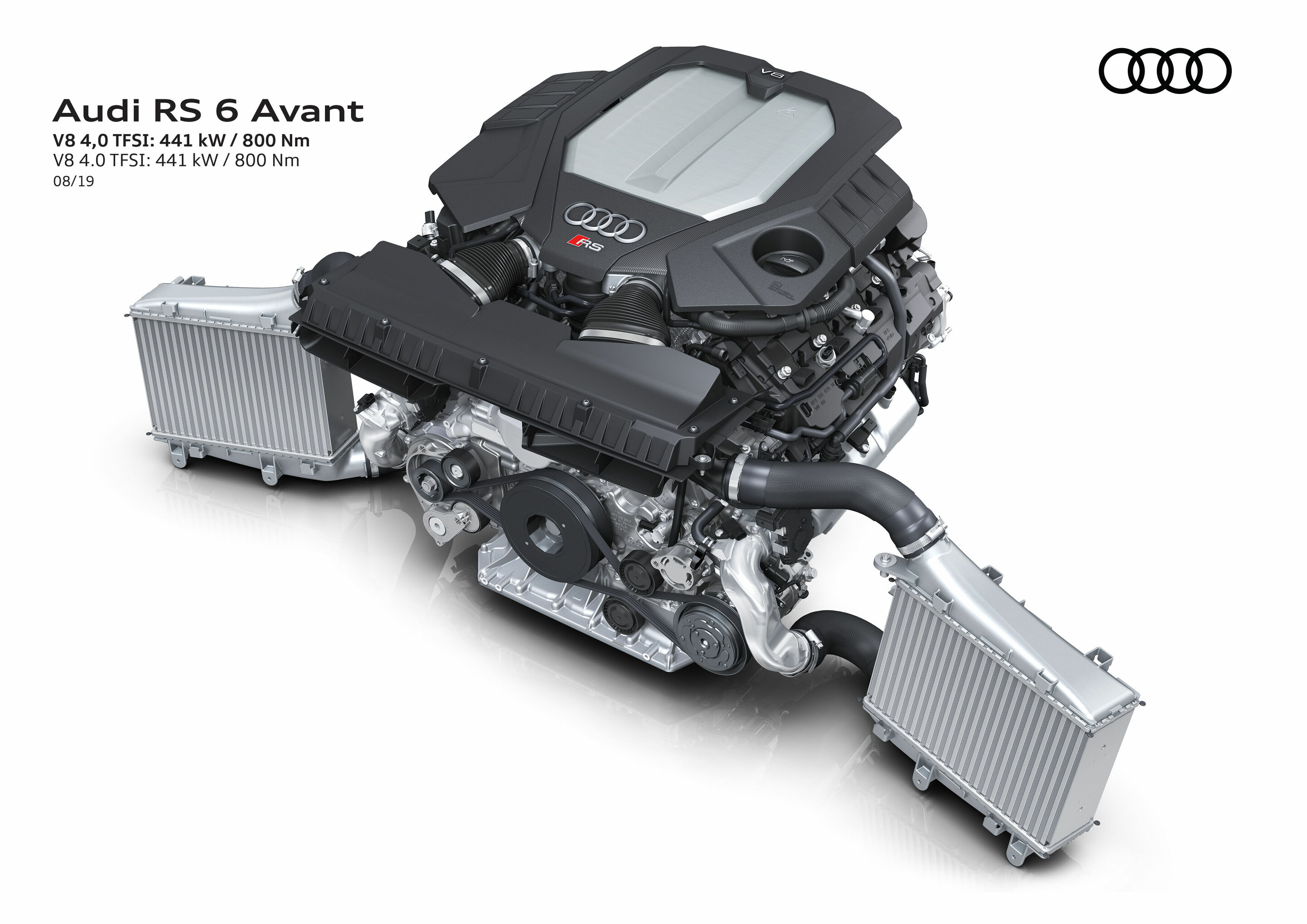The twin-turbo V8 delivers 441 kW (600 PS) and provides a constant 800 Nm (590.0 lb-ft) of torque within a wide engine speed range from 2,050 to 4,500 rpm. The high-performance Avant takes just 3.6 seconds to complete the sprint from zero to 100 km/h (62.1 mph). And in a mere 12 seconds, the RS 6 Avant reaches 200 km/h (124.3 mph). The top speed is electronically limited to 250 km/h (155.3 mph); this can be increased to 280 km/h (174 mph) with the dynamic package and even to 305 km/h (189.5 mph) with the dynamic plus package.
| Audi RS 6 Avant | 4.0 TFSI |
| Displacement in cc | 3.996 |
| Max. power output in kW (PS) at rpm | 441 (600) at 6.000–6.250 |
| Max. torque in Nm (lb-ft) at rpm | 800 (590.0) at 2.050–4.500 |
| Top speed in km/h (mph) | 250 (280/305) (155.3 (174.0/189.5)) |
| Acceleration 0–100 km/h (62.1 mph) in s | 3,6 s |
| Fuel consumption (combined) in l/100 km (mpg) | 12,7–12,1 (18.5–19.4) |
| Combined CO2 emissions in g/km (g/mi) | 289–276 (465.1–444.2) |
| Drive | quattro permanent all-wheel drive |
| Transmission | Eight-speed tiptronic |
Larger turbochargers and an increase in boost pressure from 2.4 to 2.6 bar in the 4.0-liter V8 biturbo TFSI engine that the RS 6 Avant performance boast, allow an increase of 30 PS in engine power and 50 Nm more torque compared to the base versions.
This means a total increase in power from 441 kW (600 PS) to 463 kW (630 PS) and in maximum torque from 800 to 850 Nm. The performance model sprint from 0 to 100 km/h in 3.4 seconds, 0.2 seconds faster than the RS 6 base version.
| Audi RS 6 Avant performance | 4.0 TFSI quattro |
| Displacement in cc | 3,996 |
| Max. power output in kW (PS) at rpm | 463 (630) at 6,000 |
| Max. torque in Nm (lb-ft) at rpm | 850 (626.9) at 2,300–4,500 |
| Top speed in km/h (mph) | 280 (280/305) (155.3 (174.0/189.5)) |
| Acceleration 0 to 100 km/h (62.1 mph) in s | 3.4 |
| Fuel consumption (combined) in l/100 km (mpg) | 12.7–12.2 (18.5–19.3) |
| Combined CO2 emissions in g/km (g/mi) | 289–277 (465.1–445.8) |
| Drive | quattro permanent all-wheel drive |
| Transmission | eight-speed tiptronic |
The twin-turbo V8 engine has a conventional 90-degree bank angle and a displacement of 3,996 cc (bore x stroke: 86.0 x 86.0 millimeters (3.4 in x 3.4 in)). Its crankcase is made of cast aluminum and weighs just 39.1 kilograms (86.2 lb). The cylinder linings have been machined with the aid of atmospheric plasma spraying. This method involves applying an extremely thin iron coating to the cylinder linings. These coated cylinder linings improve heat dissipation, thermal and mechanical resilience, and wear resistance. They also reduce internal friction significantly and ensure minimum oil consumption. An electronic valve located centrally in the inside V also regulates the map-controlled piston spray nozzles as required for piston cooling. This decreases the power requirements of the oil pump.
A fully variable pump drives the oil circuit. It is split into two separate oil galleries – one for the engine block and one for the cylinder heads. This layout ensures a reliable supply of oil even under the extreme lateral and longitudinal acceleration that the Audi RS 6 Avant and the RS 6 Avant performance is capable of achieving. The switchable water pump is only engaged from a temperature of 80 degrees Celsius (176 °F), as the coolant, which is stagnant at first, heats up more quickly and the engine reaches its operating temperature sooner. The chains of the valve gear are driven by a geared intermediate shaft. This also drives the water pump. To ensure that the cylinders are filled optimally, intake and exhaust camshafts can be adjusted by 50 degrees. Each cylinder bank drives a high-pressure fuel pump that builds up pressure of up to 250 bar. The injectors, located in the center of the combustion chamber, inject the fuel through seven holes, following special injection strategies depending on the requirements, from cold start to full load. The firing order is the same as that of the predecessor engine: 1-3-7-2-6-5-4-8.
The 4.0 TFSI produces a full-bodied and sporty V8 sound. The driver can influence the full sound of the power unit using the Audi drive select dynamic handling system. The Audi drive select system influences the engine and transmission management, the power steering, the suspension, the dynamic all-wheel steering, the quattro sport differential, the engine sound, and the way in which the automatic air conditioning works. The optional RS sport exhaust system with black tailpipe trim provides an even fuller sound. In the customizable RS1 and RS2 modes, customers decide themselves whether the four-liter engine should sound sporty or balanced.
Forceful: two twin-scroll turbochargers
The powerful torque that the 4.0 TFSI builds up even at slow speeds is mainly owed to the two twin-scroll turbochargers. In addition to elevated boost pressure, the diameter of the compressor wheel of the turbochargers has been increased by three millimeters (0.1 in). Each turbo supplies one cylinder bank with up to 1.4 bar of boost pressure (relative). This is 0.2 bar more than the predecessor. The increased boost pressure allows more air into the combustion chamber for the fuel combustion, which improves the fill level of the cylinders. This results in higher engine power and improved efficiency.
The cylinder heads have the intake side on the outside and the exhaust side on the inside. This allows the larger turbos in the 90-degree inside V of the cylinder banks rather than in the usual location outside the side of the engine. This layout enables short gas flow paths with minimal flow losses and spontaneous engine response. Elaborate and effective insulation of hot components ensures thermally stable conditions in the inside V. The compression ratio is 10.1 : 1 for the RS 6 Avant and 9.7 : 1 for the RS 6 Avant performance.
Efficient systems: MHEV and cylinder on demand (COD)
Thanks to its mild hybrid system (MHEV) with a 48-volt main on-board electrical system, the 4.0 TFSI combines maximum performance with high efficiency. The heart of this system, the belt alternator starter, can recover up to 12 kW of power under gentle acceleration and feed it into a lithium-ion battery as energy.
If the driver releases the accelerator at a speed between 55 and 160 km/h (34.2 to 99.4 mph), the drive management will select one of two options. Depending on the driving situation and the settings in the Audi drive select dynamic handling system, the RS 6 Avant and RS 6 Avant performance recovers, i.e. the alternator converts kinetic energy into electric energy so that it decelerates, or it coasts with the engine switched off. Pressing the accelerator makes the belt alternator starter restart the engine.
MHEV technology allows for start/stop operation even in all ranges below a residual speed of 22 km/h (13.7 mph). Fuel savings of up to 0.8 liters per 100 kilometers are possible in everyday driving.
The cylinder on demand (COD) system is another measure onboard the vehicle that benefits efficiency. In higher gears at low to medium loads and engine speeds, it will switch off cylinders 2, 3, 5, and 8 by halting injection and ignition and closing the intake and exhaust valves. Due to the four-cylinder operation, the operating points in the active cylinders are displaced toward higher loads in areas of the characteristic map with higher efficiency, while the deactivated cylinders largely run without losses, like gas springs. When the driver presses the accelerator pedal, they are reactivated instantly. Each switchover takes mere milliseconds and is virtually undetectable by the driver and passengers.
All terms marked in the text are explained in detail in the technology lexicon at www.audi-mediacenter.com/en/technology-lexicon.
The specified equipment, data and prices relate to the model range on offer in Germany. Subject to changes and errors. Figures on the fuel consumption and the CO2-emissions (found from page 2 onwards) vary in case of given ranges depending on the used combination of wheels/tires.

